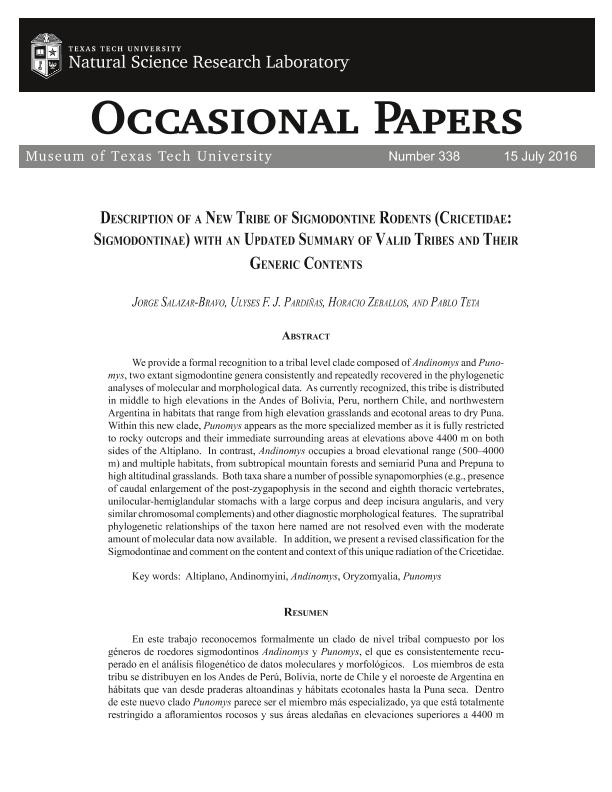Artículo
We provide a formal recognition to a tribal level clade composed of Andinomys and Punomys , two extant sigmodontine genera consistently and repeatedly recovered in the phylogenetic analyses of molecular and morphological data. As currently recognized, this tribe is distributed in middle to high elevations in the Andes of Bolivia, Peru, northern Chile, and northwestern Argentina in habitats that range from high elevation grasslands and ecotonal areas to dry Puna. Within this new clade, Punomys appears as the more specialized member as it is fully restricted to rocky outcrops and their immediate surrounding areas at elevations above 4400 m on both sides of the Altiplano. In contrast, Andinomys occupies a broad elevational range (500–4000 m) and multiple habitats, from subtropical mountain forests and semiarid Puna and Prepuna to high altitudinal grasslands. Both taxa share a number of possible synapomorphies (e.g., presence of caudal enlargement of the post-zygapophysis in the second and eighth thoracic vertebrates, unilocular-hemiglandular stomachs with a large corpus and deep incisura angularis, and very similar chromosomal complements) and other diagnostic morphological features. The supratribal phylogenetic relationships of the taxon here named are not resolved even with the moderate amount of molecular data now available. In addition, we present a revised classification for the Sigmodontinae and comment on the content and context of this unique radiation of the Cricetidae. En este trabajo reconocemos formalmente un clado de nivel tribal compuesto por los géneros de roedores sigmodontinos Andinomys y Punomys , el que es consistentemente recuperado en el análisis filogenético de datos moleculares y morfológicos. Los miembros de esta tribu se distribuyen en los Andes de Perú, Bolivia, norte de Chile y el noroeste de Argentina en hábitats que van desde praderas altoandinas y hábitats ecotonales hasta la Puna seca. Dentro de este nuevo clado Punomys parece ser el miembro más especializado, ya que está totalmente restringido a afloramientos rocosos y sus áreas aledañas en elevaciones superiores a 4400 m en ambos lados del Altiplano. En contraste, Andinomys ocupa múltiples ambientes en elevaciones que van desde 500–4000 m y que incluyen bosques subtropicales de montaña, Puna y pre-Puna semiáridas y pastizales de altura. Andinomys y Punomys comparten una serie de posibles sinapomorfías (por ejemplo, ampliación caudal de la postzigapófisis de la segunda y octava vertebras torácicas, estómagos uniloculares y hemiglandulares con incisura y corpus especialmente prominentes y complementos cromosómicos muy similares) entre otras características morfológicas diagnósticas. Las relaciones filogenéticas supratribales del taxón aquí nombrado no se resuelven incluso con una cantidad moderada de datos moleculares. Por último, se presenta una clasificación actualizada para la subfamilia Sigmodontinae y se ofrecen comentarios sobre el contenido y el contexto de esta singular radiación de los Cricetidae.
Description of a new tribe of sigmodontine rodents (Cricetidae: Sigmodontinae) with an updated summary of valid tribes and their generic contents
Fecha de publicación:
15/07/2016
Editorial:
Texas Tech Universtiy. Natural Science Research Laboratory
Revista:
Occasional Papers
ISSN:
0149-175X
Idioma:
Inglés
Tipo de recurso:
Artículo publicado
Clasificación temática:
Resumen
Palabras clave:
Altiplano
,
Andinomyini
,
Andinomys
,
Oryzomyalia
,
Punomys
Archivos asociados
Licencia
Identificadores
Colecciones
Articulos(IDEAUS)
Articulos de INSTITUTO DE DIVERSIDAD Y EVOLUCION AUSTRAL
Articulos de INSTITUTO DE DIVERSIDAD Y EVOLUCION AUSTRAL
Citación
Salazar Bravo, Jorge; Pardiñas, Ulises Francisco J.; Zeballos, Horacio; Teta, Pablo Vicente; Description of a new tribe of sigmodontine rodents (Cricetidae: Sigmodontinae) with an updated summary of valid tribes and their generic contents; Texas Tech Universtiy. Natural Science Research Laboratory; Occasional Papers; 338; 15-7-2016; 1-23
Compartir




